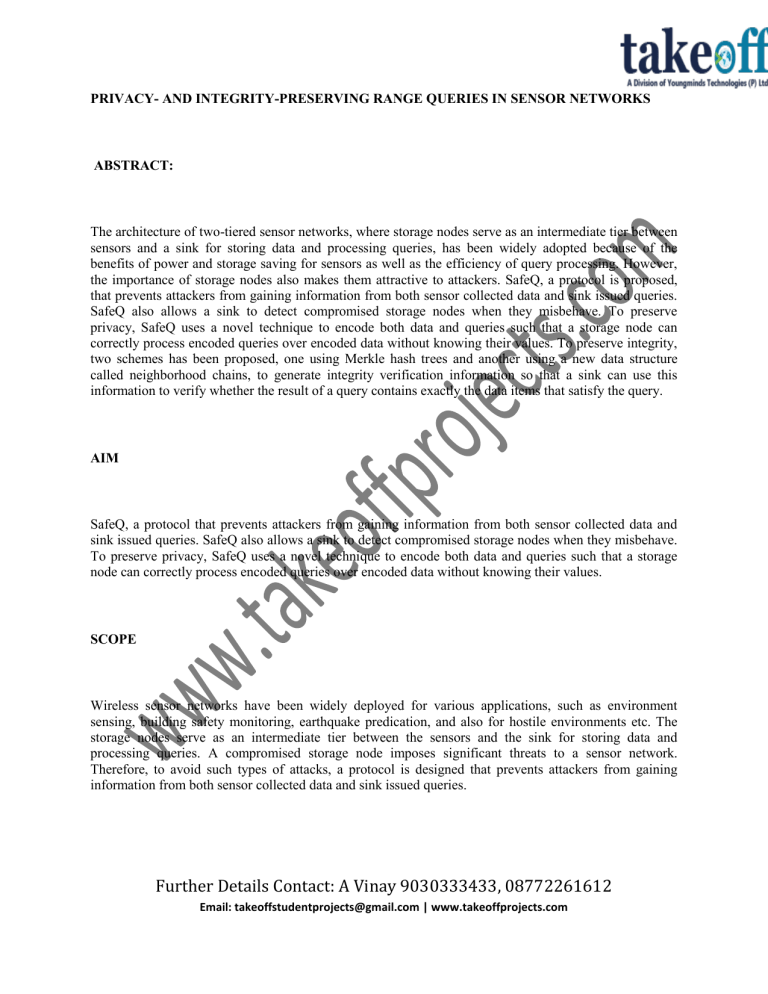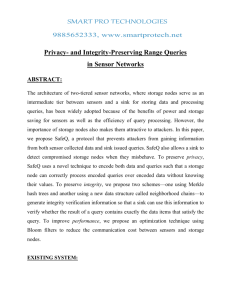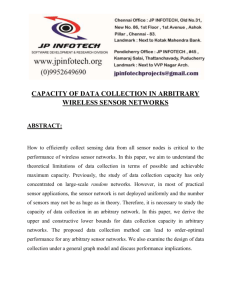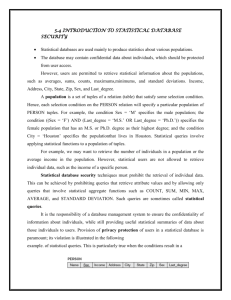PRIVACY- AND INTEGRITY-PRESERVING RANGE QUERIES IN

PRIVACY- AND INTEGRITY-PRESERVING RANGE QUERIES IN SENSOR NETWORKS
ABSTRACT:
The architecture of two-tiered sensor networks, where storage nodes serve as an intermediate tier between sensors and a sink for storing data and processing queries, has been widely adopted because of the benefits of power and storage saving for sensors as well as the efficiency of query processing. However, the importance of storage nodes also makes them attractive to attackers. SafeQ, a protocol is proposed, that prevents attackers from gaining information from both sensor collected data and sink issued queries.
SafeQ also allows a sink to detect compromised storage nodes when they misbehave. To preserve privacy, SafeQ uses a novel technique to encode both data and queries such that a storage node can correctly process encoded queries over encoded data without knowing their values. To preserve integrity, two schemes has been proposed, one using Merkle hash trees and another using a new data structure called neighborhood chains, to generate integrity verification information so that a sink can use this information to verify whether the result of a query contains exactly the data items that satisfy the query.
AIM
SafeQ, a protocol that prevents attackers from gaining information from both sensor collected data and sink issued queries. SafeQ also allows a sink to detect compromised storage nodes when they misbehave.
To preserve privacy, SafeQ uses a novel technique to encode both data and queries such that a storage node can correctly process encoded queries over encoded data without knowing their values.
SCOPE
Wireless sensor networks have been widely deployed for various applications, such as environment sensing, building safety monitoring, earthquake predication, and also for hostile environments etc. The storage nodes serve as an intermediate tier between the sensors and the sink for storing data and processing queries. A compromised storage node imposes significant threats to a sensor network.
Therefore, to avoid such types of attacks, a protocol is designed that prevents attackers from gaining information from both sensor collected data and sink issued queries.
Further Details Contact: A Vinay 9030333433, 08772261612
Email: takeoffstudentprojects@gmail.com | www.takeoffprojects.com
PROBLEM DEFINITION
The inclusion of storage nodes in wireless sensor networks brings significant security challenges. As storage nodes store data received from sensors and serve as an important role for answering queries, they are more vulnerable to be compromised, especially in a hostile environment. A compromised storage node imposes significant threats to a sensor network. First, the attacker may obtain sensitive data that has been, or will be, stored in the storage node. Second, the compromised storage node may return forged data for a query. Third, this storage node may not include all data items that satisfy the query.
PROBLEM SOLUTION
A compromised storage node imposes significant threats to a sensor network. Therefore, to avoid such types of attacks, a protocol is designed that prevents attackers from gaining information from both sensor collected data and sink issued queries, which typically can be modeled as range queries, and allows the sink to detect compromised storage nodes when they misbehave. For privacy, compromising a storage node should not allow the attacker to obtain the sensitive information that has been, and will be, stored in the node, as well as the queries that the storage node has received, and will receive.
Queries from the sink as treated confidential because such queries may leak critical information about query issuers’ interests, which need to be protected especially in military applications. For integrity, the sink needs to detect whether a query result from a storage node includes forged data items or does not include all the data that satisfy the query. A storage node needs to correctly process encoded queries over encoded data without knowing their actual values. A sink needs to verify that the result of a query contains all the data items that satisfy the query and does not contain any forged data.
INTRODUCTION
Wireless sensor networks (WSNs) have been widely deployed for various applications, such as environment sensing, building safety monitoring, earthquake predication, etc. In this paper, we consider a two-tiered sensor network architecture in which storage nodes gather data from nearby sensors and answer queries from the sink of the network. The storage nodes serve as an intermediate tier between the sensors and the sink for storing data and processing queries. Storage nodes bring three main benefits to sensor networks. First, sensors save power by sending all collected data to their closest storage node instead of sending them to the sink through long routes. Second, sensors can be memory-limited because
Further Details Contact: A Vinay 9030333433, 08772261612
Email: takeoffstudentprojects@gmail.com | www.takeoffprojects.com
data are mainly stored on storage nodes. Third, query processing becomes more efficient because the sink only communicates with storage nodes for queries.
EXISTING SYSTEM
Existing Wireless sensor networks once sensor nodes have been deployed, there will be minimal manual intervention and monitoring. But, when nodes are deployed in a hostile environment and there is no manual monitoring.
The prior art solution to this problem was proposed by Sheng and Li in their recent seminal work. It is
“S&L scheme.”
Disadvantages
It allows attackers to obtain a reasonable estimation on both sensor collected data and sink issued queries; and
The power consumption and storage space for both sensors and storage nodes grow exponentially with the number of dimensions of collected data.
PROPOSED SYSTEM
Proposed a SafeQ, novel privacy- and integrity-preserving range query protocol for two-tiered sensor networks.
To preserve privacy, SafeQ uses a novel technique to encode both data and queries such that a storage node can correctly process encoded queries over encoded data without knowing their actual values.
To preserve integrity, two schemes has been proposed one using Merkle hash trees and another using a new data structure called neighborhood chains to generate integrity verification information such that a sink can use this information to verify whether the result of a query contains exactly the data items that satisfy the query.
Advantages
SafeQ provides significantly better security and privacy.
Further Details Contact: A Vinay 9030333433, 08772261612
Email: takeoffstudentprojects@gmail.com | www.takeoffprojects.com
SafeQ delivers orders of magnitude better performance on both power consumption and storage space for multidimensional data, which are most common in practice as most sensors are equipped with multiple sensing modules such as temperature, humidity, pressure, etc.
Architecture of two-tired sensor networks
MODULE DESCRIPTION :
SafeQ
SafeQ is a protocol that prevents attackers from gaining information from both sensor collected data and sink issued queries. SafeQ also allows a sink to detect compromised storage nodes when they misbehave. To preserve privacy , SafeQ uses a novel technique to encode both data and queries such that a storage node can correctly process encoded queries over encoded data without knowing their values.
Further Details Contact: A Vinay 9030333433, 08772261612
Email: takeoffstudentprojects@gmail.com | www.takeoffprojects.com
Integrity
The sink needs to detect whether a query result from a storage node includes forged data items or does not include all the data that satisfy the query. There are two key challenges in solving the privacy and integrity-preserving range query problem. First, a storage node needs to correctly process encoded queries over encoded data without knowing their actual values.
Second, a sink needs to verify that the result of a query contains all the data items that satisfy the query and does not contain any forged data.
Privacy
To preserve privacy,SafeQ uses a novel technique to encode both data and queries such that a storage node can correctly process encoded queries over encoded data without knowing their actual values.
Range Queries
The queries from the sink are range queries. A range query “finding all the data items collected at time-slot in the range ” is denoted as . Note that the queries in most sensor network applications can be easily modeled as range queries.
Sink
The sink is the point of contact for users of the sensor network. Each time the sink receives a question from a user, it first translates the question into multiple queries and then disseminates the queries to the corresponding storage nodes, which process the queries based on their data and return the query results to the sink. The sink unifies the query results from multiple storage nodes into the final answer and sends it back to the user.
sink can detect compromised storage nodes when they misbehave.
Further Details Contact: A Vinay 9030333433, 08772261612
Email: takeoffstudentprojects@gmail.com | www.takeoffprojects.com
Storage Node
Storage nodes are powerful wireless devices that are equipped with much more storage capacity and computing power than sensors.The storage node collects all data from the sensor nodes. The storage node can’t view the actual value of sensor node data. If the storage node trying to view the sensor node data, sink detect misbehave of storage node.
CONCLUSION
We make three key contributions in this paper. First, we propose SafeQ, a novel and efficient protocol for handling range queries in two-tiered sensor networks in a privacy- and integrity- preserving fashion.
SafeQ uses the techniques of prefix membership verification, Merkle hash trees, and neighborhood chaining. In terms of security, SafeQ significantly strengthens the security of two-tiered sensor networks.
Unlike prior art, SafeQ prevents a compromised storage node from obtaining a reasonable estimation on the actual values of sensor collected data items and sink issued queries. In terms of efficiency, our results show that SafeQ significantly outperforms prior art for multidimensional data in terms of both power consumption and storage space. Second, we propose an optimization technique using Bloom filters to significantly reduce the communication cost between sensors and storage nodes. Third, we propose a solution to adapt SafeQ for event-driven sensor networks.
Further Details Contact: A Vinay 9030333433, 08772261612
Email: takeoffstudentprojects@gmail.com | www.takeoffprojects.com






